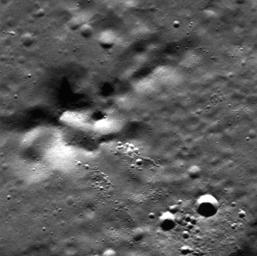The mounds in this image are the central peak of an unnamed crater approximately 47 km in diameter, imaged at such high resolution (18 meters/pixel) that only the crater's interior can be seen. Central peaks are of great interest because they expose material that originally resided at depth in the target material.
This image was acquired as a high-resolution targeted observation. Targeted observations are images of a small area on Mercury's surface at resolutions much higher than the 250-meter/pixel (820 feet/pixel) morphology base map or the 1-kilometer/pixel (0.6 miles/pixel) color base map. It is not possible to cover all of Mercury's surface at this high resolution during MESSENGER's one-year mission, but several areas of high scientific interest are generally imaged in this mode each week.
On March 17, 2011 (March 18, 2011, UTC), MESSENGER became the first spacecraft ever to orbit the planet Mercury. The mission is currently in its commissioning phase, during which spacecraft and instrument performance are verified through a series of specially designed checkout activities. In the course of the one-year primary mission, the spacecraft's seven scientific instruments and radio science investigation will unravel the history and evolution of the Solar System's innermost planet. Visit the Why Mercury? section of this website to learn more about the science questions that the MESSENGER mission has set out to answer.
Date acquired: April 10, 2011
Image Mission Elapsed Time (MET): 210938843
Image ID: 114409
Instrument: Narrow Angle Camera (NAC) of the Mercury Dual Imaging System (MDIS)
Center Latitude: 71.02°
Center Longitude: 328.5° E
Resolution: 18 meters/pixel
Scale: The image is approximately 18 km across
Incidence Angle: 71.0°
Emission Angle: 3.9°
Phase Angle: 74.9°
These images are from MESSENGER, a NASA Discovery mission to conduct the first orbital study of the innermost planet, Mercury. For information regarding the use of images, see the MESSENGER image use policy.

 Planetary Data System
Planetary Data System












